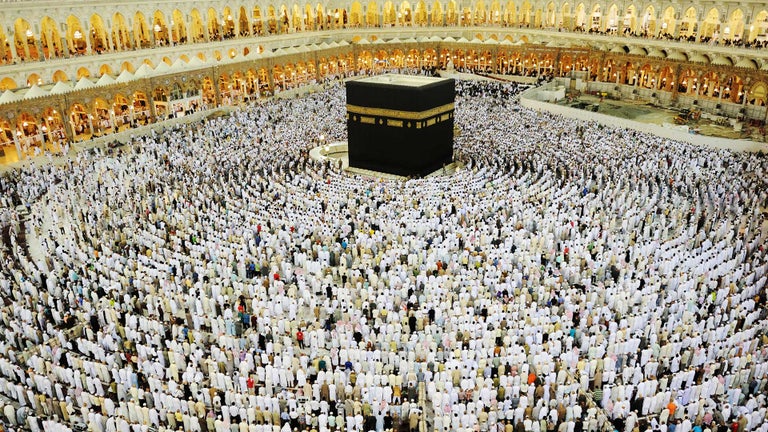Eid Prayers in Islam: How to Pray Eid Prayers, Dua, Importance (Everything You Need to Know)

Introduction to Eid Prayers in Islam
Eid Prayers in Islam – The Eid prayer holds profound significance within the Islamic calendar, symbolizing a joyous occasion that unites the Muslim community in devotion. It comprises two main Eid prayers; Eid-ul-Fitr and Eid-ul-Adha – each observed with distinct rituals and practices. Muslims gather as a congregation to offer prayers, expressing gratitude to Allah and nurturing a sense of fraternity and belonging among themselves.
At the heart of the Eid prayer is the dua, or supplication, “Taqabbal Allahu minna wa minkum,” which serves as a beautiful expression of congratulations exchanged among Muslims on this auspicious day. Understanding the method of performing the Eid prayer is crucial, as it occurs only twice a year and involves specific recitations and actions.
Even when performed at home, Eid prayers adhere to a similar structure as those conducted in mosques, albeit with some variations. While Eid prayer is not obligatory for women, it is highly encouraged as a Sunnah, or tradition, within Islam.
A vital aspect of Eid celebrations is the Eid prayer, which can be performed following this guide’s step-by-step method. Muslims gather as a congregation to offer prayers and express gratitude to Allah on this auspicious day. Ameen, may all your prayers be answered!
Related: Daytime intercourse during Ramadan attracts 60-day redemption fast – Ilorin Imam, Ajijolakewu
Eid Prayers in Islam

Eid prayer carries profound significance in the Islamic calendar, signifying a momentous occasion that brings together the Muslim community in worship. As Eid is celebrated twice a year, it’s important to revisit the procedures and customs associated with this auspicious event.
Led by the Imam, the Eid prayer stands as a central element of the festivities, demanding meticulous attention to its recitations and adherence to its unique rituals. Through simple instructions, we can ensure active participation in this prayer, reaping the blessings and rewards bestowed by Allah (SWT).
Related: Ramadan 2024: Dua’s, Most Common Questions and Answers Muslims Ask During Ramadan
The Two Eid Prayers in Islam
Eid-ul-Fitr and Eid-ul-Adha are the two primary Eid prayers observed in Islam. While the dates of Eid are widely known among many Muslims, individuals who have recently embraced Islam may still be unfamiliar with the concept of multiple Eids in the Islamic calendar.
Prophet Muhammad (PBUH) himself designated Eid-ul-Fitr and Eid-ul-Adha as occasions for celebration in the Islamic calendar. Despite sharing the common abbreviation “Eid,” these celebrations differ significantly in their observance and the respective months in which they occur.
See Also: Ramadan 2024: The Significance of Moon Sighting in Islam, Why it is Important
Importance of Eid Prayers in Islam

Eid prayers, conducted in congregations comprising friends, family, and fellow Muslims, allow individuals worldwide to express gratitude to Allah and foster a sense of unity and belonging. Moreover, prayers have a direct impact on one’s life, leading to significant outcomes and benefits.
Also Read: Top 10 Things to Avoid During Ramadan 2024
Eid Prayer Dua
The Eid prayer dua, as narrated by Jubayr ibn Nufayr, serves as a beautiful expression of congratulations exchanged among the companions of Prophet Muhammad (peace and blessings of Allah be upon him) on the day of Eid. Traditionally recited in Arabic:
“تَقَبَّلَ اللهُ مِنَّا وَمِنكُم”
Transliteration:
“Taqabbal Allahu minna wa minkum”
Interpretation:
“May Allah accept from us and from you.” or “May Allah accept this worship from both you and us.”
Through understanding and practicing the Eid prayer and its associated customs, individuals can deepen their spiritual connection and fully partake in the blessings of this sacred occasion.
How to Pray Eid Prayers in Islam

Praying the Eid prayer holds immense significance in the Islamic calendar, yet it’s a ritual observed only twice a year. Therefore, understanding its procedure is paramount to ensure its proper execution. Here’s a comprehensive guide to performing the Eid prayer:
Number of Rakats in Eid Prayer:
The Eid prayer consists of two rak’ahs (units) and includes additional takbeers. These are performed silently, without verbal expression.
Recitation during Eid Prayer:
Upon initiating the prayer, the first takbeer, known as takbeerat-ul-ihram (Allahu Akbar), is uttered. Subsequently, the first rak’ah comprises six additional takbeers. There’s no requirement to recite the opening supplication during this phase.
Step-by-Step Procedure to Eid Prayers in Islam:
- Preparation: Adorn your finest attire and perform ghusl (ritual purification), as it’s Sunnah (recommended) before attending the Eid prayer. Additionally, recite takbeer as you depart from your home, following the Sunnah tradition.
- Intention (Niyyah): Set your intention for the Eid prayer internally, focusing your heart on the worship of Allah.
Initiating the Prayer:
- Raise your hands to shoulder level (for women) or earlobes (for men) while saying the takbeer, “Allahu Akbar.” Place your right hand over your left slightly below the navel (or beneath the chest for women).
- Opening Supplication: Begin with the prayer “SubhanaK-Allahumma wa bihamdiKa, wa tabaarak-asmuKa, wa ta-’aala jadduKa, wa la ilaaha ghayruK,” acknowledging the divine glory of Allah.
- Takbeers: The Imam will lead multiple takbeers, during which you raise your hands to shoulder or ear level and then lower them to your sides. The number of takbeers may vary, usually three according to Hanafi tradition.
- Follow the Imam: Pay close attention to the Imam’s instructions and follow their lead throughout the prayer.
- Rak’ah Completion: Complete the remainder of the rak’ah as you would in regular obligatory prayers.
Subsequent Rak’ah:
- Recitation: In the second rak’ah, the Imam will recite Surah al-Fatihah followed by another surah.
- Additional Takbeers: Following the Qur’anic recital, the Imam will lead additional takbeers, and you should follow suit as before.
- Bowing Stance (Ruku): Proceed to bow down into a ruku position after the takbeers.
- Continuation: Complete the remaining rak’ah following the standard format of your obligatory prayers.
- Sermon (Khutbah): Following the prayer, listen attentively to the khutbah (sermon) delivered by the Imam. The khutbah may cover various Islamic topics and is an integral part of the Eid congregation.
By adhering to these steps, you can perform the Eid prayer with reverence and adherence to Islamic tradition, ensuring its significance is honored and celebrated appropriately.
What to do After Eid Prayers in Islam?

Upon completing the Eid Prayer, it is recommended to take a different route on your way home. This practice is based on a narration by Abu Huraira, in which it is mentioned that the Prophet Muhammad (peace be upon him) would return home via a different path from the one he took when going for the Eid Prayer.
Choosing an alternative route after the Eid Prayer serves as a symbolic gesture, signifying your attendance at this special congregational prayer. On the Day of Judgment, both routes will bear witness to your participation in this important act of worship.
In following the footsteps of the Prophet Muhammad (peace be upon him), we emulate his actions and teachings, seeking to embody his noble character and adherence to religious practices.
Therefore, after offering the Eid Prayer, consider taking a different path home as a reflection of this tradition and as a means to uphold the Sunnah of the Prophet.
Eid Prayers at Home
Performing Eid prayers at home mirrors the structure of those conducted at the mosque, albeit with some notable distinctions. Typically, an adult male family member leads the prayer as the imam, with other family members forming the congregation. The timing for Eid salah at home typically commences fifteen minutes after daybreak and concludes ten to fifteen minutes before Dhuhr, or midday.
During the prayer, the imam recites the takbeers and surahs from the Qur’an aloud, while the congregation follows along silently. Unlike the Eid prayer at the mosque, there is no khutbah (Eid sermon) delivered at home. Nevertheless, it is crucial to adhere to the customary prayer protocols, ensuring that the essence and significance of Eid are maintained even within the confines of a home setting.
Is Eid Prayers Compulsory for Women?
No, Eid prayers are not mandatory for women. However, it is recommended as a Sunnah.
What Happens if You Skip Eid Prayers in Islam?
Missing Eid prayers does not incur sin, and life continues as usual. However, it is encouraged to participate in these prayers to partake in the festive spirit bestowed by Allah (SWT) and to connect with fellow community members whom you may rarely encounter otherwise.
Conclusion on Eid Prayers in Islam
In summary, the Eid prayer stands as a pivotal aspect of Eid festivities, encapsulating the essence of gratitude, unity, and devotion shared by Muslims globally. A comprehensive comprehension of its significance, rituals, and customs guarantees a meaningful commemoration of this auspicious occasion.
Whether conducted in the mosque or within the confines of one’s home, the Eid prayer fosters stronger bonds of community and faith, underscoring the core values of Islam. As the joyous occasion of Eid draws near, let us eagerly seize the chance to partake in this profound act of worship and celebration. Eid Mubarak to one and all!





